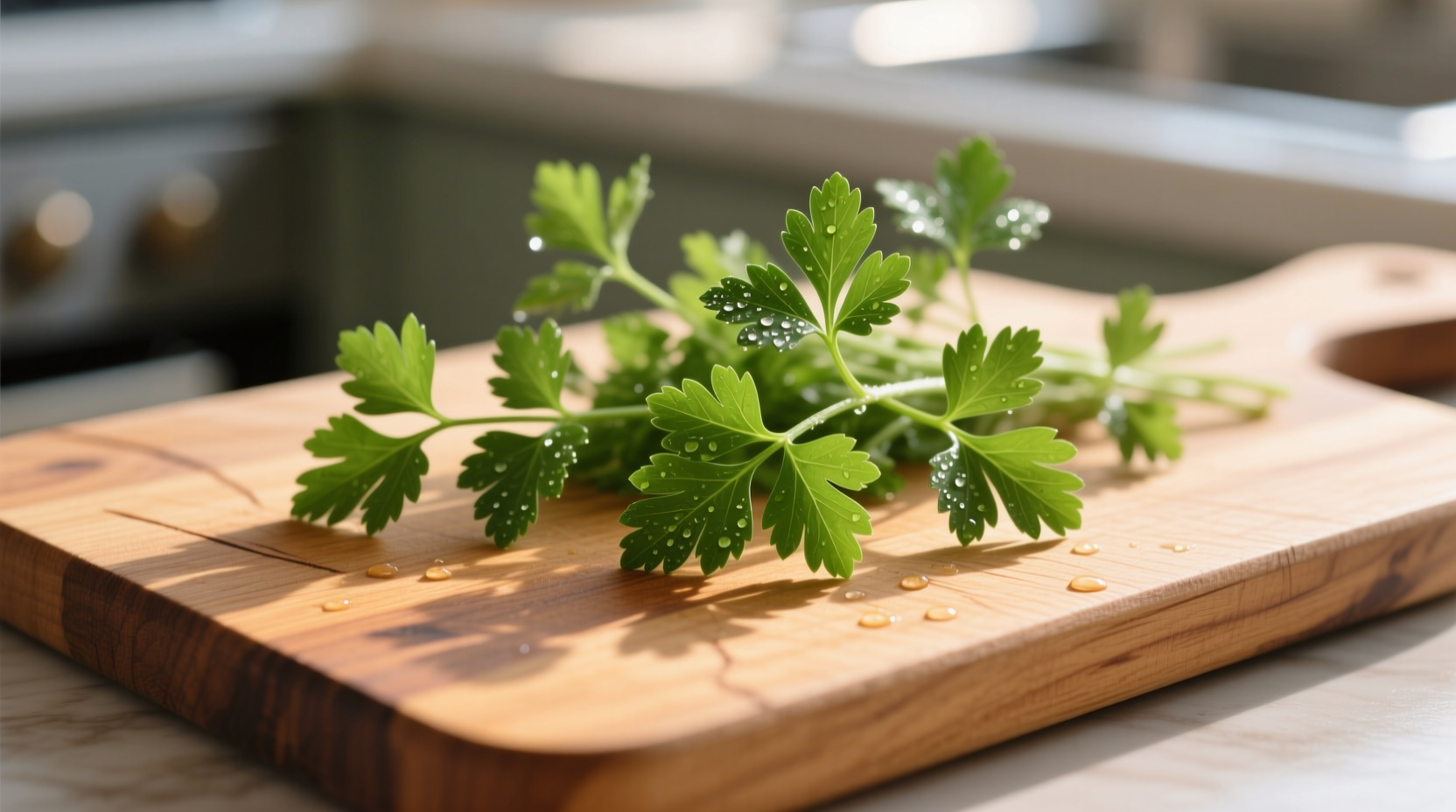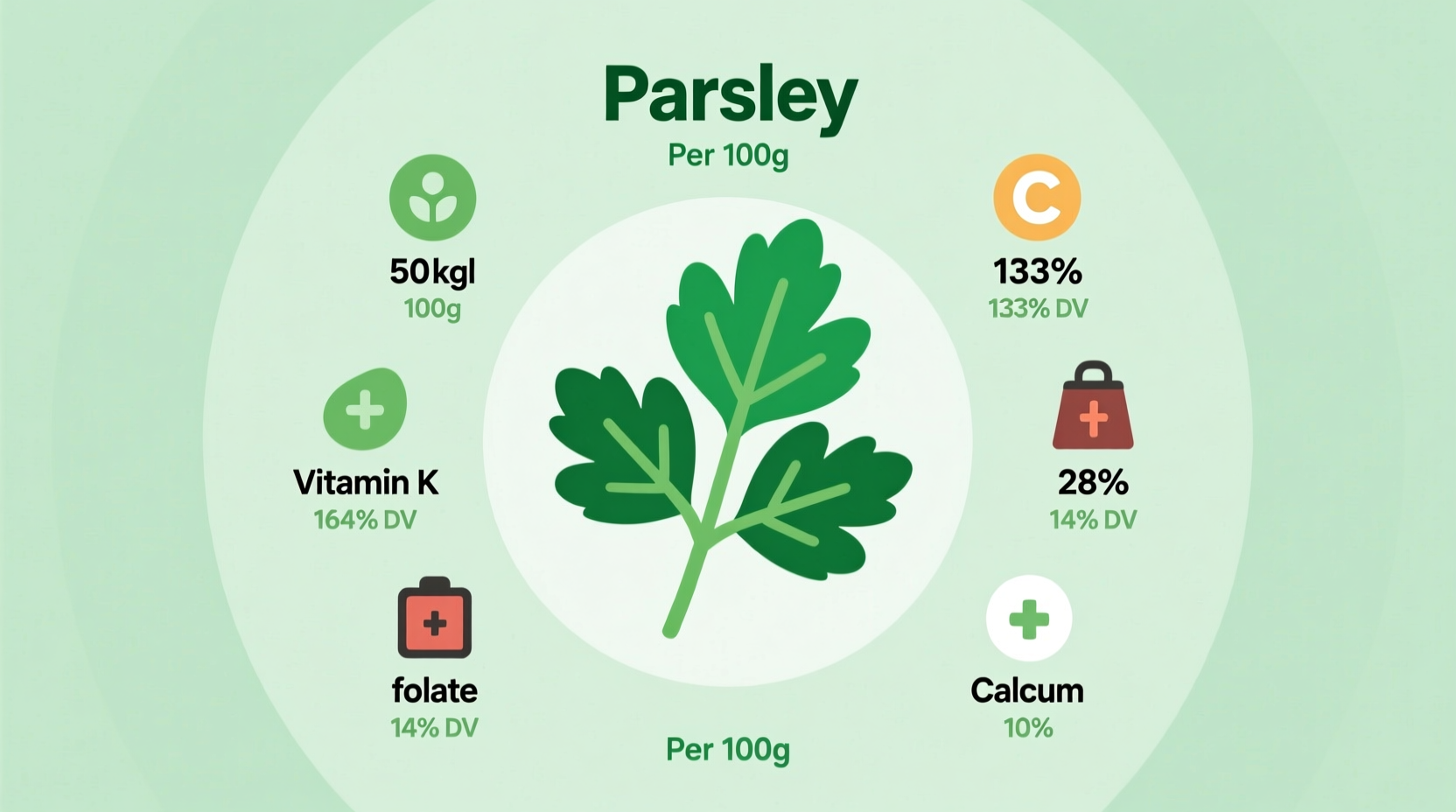One cup (60g) of fresh parsley contains just 22 calories yet delivers over 1,200% of your daily vitamin K needs, 133% of vitamin C, and significant amounts of vitamin A, iron, and folate. This nutrient-dense herb offers powerful antioxidant benefits while supporting bone health, immunity, and cardiovascular function.
When you reach for that bunch of vibrant green parsley at the grocery store, you're grabbing one of nature's most potent nutritional powerhouses. Often relegated to a mere garnish, this humble herb deserves a starring role in your diet for its exceptional nutrient density and science-backed health benefits. Let's explore why nutritionists consistently rank parsley among the top functional foods you can incorporate into your daily meals.
Core Nutritional Profile: What Makes Parsley Special
Parsley stands out in the herb category for its extraordinary concentration of essential nutrients. Unlike many herbs that primarily offer flavor with minimal nutritional impact, parsley delivers substantial health benefits in every serving. The USDA's FoodData Central database confirms that a single cup (60g) of fresh parsley provides remarkable nutritional value:
| Nutrient | Amount per 1 cup (60g) | % Daily Value |
|---|---|---|
| Calories | 22 | 1% |
| Vitamin K | 1,230 mcg | 1,025% |
| Vitamin C | 80 mg | 89% |
| Vitamin A | 5,054 IU | 101% |
| Folate | 91 mcg | 23% |
| Iron | 2.9 mg | 16% |
| Calcium | 138 mg | 14% |
This impressive nutritional profile comes with only 22 calories, making parsley an exceptionally nutrient-dense food. The data comes directly from the USDA FoodData Central, the authoritative source for nutritional information in the United States.
Vitamin K Powerhouse: Why This Matters for Your Health
Parsley's most remarkable nutritional feature is its extraordinary vitamin K content. Just one cup provides over 1,000% of your recommended daily intake. Vitamin K plays several critical roles in your body:
- Blood clotting regulation: Essential for proper coagulation to prevent excessive bleeding
- Bone metabolism: Helps bind calcium to your bone matrix, reducing osteoporosis risk
- Cardiovascular protection: Prevents calcium buildup in arteries that can lead to heart disease
A 2020 study published in the American Journal of Clinical Nutrition found that higher vitamin K intake correlated with a 21% lower risk of cardiovascular disease. The research, conducted by the Human Nutrition Research Center on Aging at Tufts University, tracked over 4,000 adults for 13 years, providing strong evidence for vitamin K's protective effects.

Antioxidant Arsenal: Beyond Basic Vitamins
Beyond its vitamin content, parsley contains several powerful antioxidant compounds that contribute to its health-promoting properties:
- Apigenin: A flavonoid with demonstrated anti-inflammatory and potential anti-cancer properties
- Luteolin: Another flavonoid that may protect against neurodegenerative diseases
- Myricetin: Associated with improved insulin sensitivity and blood sugar control
- Carotenoids: Including beta-carotene and lutein, which support eye health
According to research from the National Institutes of Health, the combination of these compounds in parsley creates a synergistic effect that enhances their individual benefits. The NIH's Office of Dietary Supplements notes that "the complex mixture of phytochemicals in whole foods like parsley often provides greater health benefits than isolated compounds."
Parsley vs. Other Herbs: Nutritional Comparison
How does parsley stack up against other common culinary herbs? This comparison reveals why parsley deserves more than just garnish status:
| Nutrient | Parsley (per 30g) | Cilantro (per 30g) | Basil (per 30g) | Mint (per 30g) |
|---|---|---|---|---|
| Vitamin K (mcg) | 615 | 31 | 54 | 18 |
| Vitamin C (mg) | 40 | 5 | 8 | 5 |
| Vitamin A (IU) | 2,527 | 327 | 1,175 | 140 |
| Iron (mg) | 1.5 | 0.2 | 0.4 | 0.4 |
This data, sourced from the USDA's National Nutrient Database, demonstrates parsley's superior nutrient density compared to other popular herbs. While all these herbs offer health benefits, parsley provides significantly higher concentrations of key vitamins and minerals.
Practical Consumption Guidelines: How Much Should You Eat?
While parsley offers impressive nutritional benefits, understanding appropriate serving sizes is crucial for maximizing benefits while avoiding potential issues:
- Daily recommendation: 1-2 cups (30-60g) of fresh parsley provides optimal nutrient intake without exceeding safe limits
- For vitamin K management: If you take blood thinners like warfarin, maintain consistent daily intake (sudden increases can interfere with medication)
- Maximizing absorption: Pair parsley with healthy fats (olive oil, avocado) to enhance absorption of fat-soluble vitamins
- Storage tips: Keep fresh parsley in a glass of water in the refrigerator (like flowers) to maintain nutrient levels for up to 1 week
It's important to note that while parsley is generally safe, extremely high consumption (several cups daily over extended periods) may cause issues for certain individuals. The European Food Safety Authority has established that moderate culinary use presents no safety concerns for the general population.
Culinary Applications That Preserve Nutritional Value
To maximize the nutritional benefits of parsley in your cooking:
- Add at the end: Incorporate fresh parsley during the last minute of cooking to preserve heat-sensitive vitamins
- Create nutrient-packed pesto: Blend with walnuts, olive oil, and lemon juice for a vitamin-rich sauce
- Make herbal tea: Steep fresh sprigs in hot water for a vitamin C boost (avoid boiling to preserve nutrients)
- Enhance salads: Combine with lemon vinaigrette to increase absorption of fat-soluble vitamins
- Freeze for later: Chop and freeze in olive oil cubes to preserve nutrients for winter cooking
Research from the Journal of Food Science shows that fresh parsley retains more nutrients when chopped just before use rather than pre-chopped and stored. The study found vitamin C levels decreased by 15% after 24 hours of refrigeration when pre-chopped.
Special Considerations and Context Boundaries
While parsley offers numerous health benefits, certain considerations are important for specific populations:
- Blood thinner users: Those taking anticoagulants should maintain consistent daily intake as vitamin K affects blood clotting
- Kidney stone risk: People prone to calcium oxalate stones may want to moderate intake as parsley contains moderate oxalates
- Pregnancy: Culinary amounts are safe, but medicinal quantities should be avoided during pregnancy
- Medication interactions: May interact with certain diuretics and lithium - consult your healthcare provider
The Mayo Clinic advises that "while parsley is safe as a food ingredient for most people, those with specific health conditions should discuss appropriate consumption levels with their healthcare provider." This context helps users make informed decisions based on their individual health circumstances.
Putting Parsley Nutrition Into Practice
Here are three simple ways to incorporate more parsley into your daily routine for maximum nutritional benefit:
- Morning green boost: Add 1/4 cup chopped parsley to your morning smoothie (combines well with citrus, cucumber, and spinach)
- Lunchtime salad upgrade: Replace 50% of lettuce in your salad with finely chopped parsley for triple the vitamin K
- Evening meal enhancement: Stir 2 tablespoons of fresh parsley into soups, stews, or grain dishes just before serving
These simple strategies can help you consistently reap parsley's nutritional benefits without dramatically changing your eating habits. Remember that consistency matters more than large occasional servings when it comes to nutrient absorption and health benefits.











 浙公网安备
33010002000092号
浙公网安备
33010002000092号 浙B2-20120091-4
浙B2-20120091-4